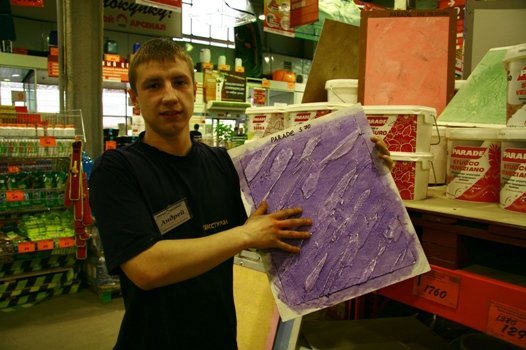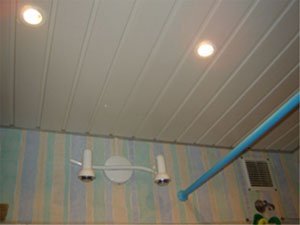Specialization: Capital construction works (foundation laying, wall erection, roof construction, etc.). Internal construction work (laying of internal communications, rough and final finishing). Hobbies: mobile communications, high technologies, computer technology, programming.
Recently, a friend of mine asked me to advise her on some finishing materials for the bathroom besides tiles. She is tired of the tile, and she does not want to follow the general trend. I then offered her a choice of several types of finishes, which, in terms of their operational properties, are excellent for use in humid air.
I think that for all novice craftsmen doing repairs with their own hands, such an instruction for choosing will not be superfluous.
Requirements for finishing materials for the bath
The main purpose of the bathroom is to perform hygiene procedures using water. Therefore, it is not surprising that the air in it is saturated with a large amount of water vapor, which can have a destructive effect on the finishing material and enclosing structures.
In addition, when taking a bath or shower, the thermal energy of the water is transferred to the air, which heats up a lot. Then, after finishing washing, the room cools down again. Constant temperature fluctuations also damage bathroom wall, floor and ceiling cladding.

Tile resists the described factors best. However, the price of this material is quite high and it is rather difficult to install. To glue ceramics on walls, you must have certain skills and abilities.
Therefore, if, due to the complexity of the implementation or for other reasons, you do not want to use this cladding, you can use other options. However, in this case, the alternative to tiles in the bathroom must meet the following requirements:
| Characteristic | Description |
| Moisture resistance | Decorative wall cladding in the bathroom must retain its performance properties regardless of the humidity level in the room. In addition, the finish should not allow water to flow to the enclosing structures in order to keep them from collapsing. |
| Durability | The longer the life of the alternative finishing material, the better. After all, you do not want to redo the repair after 2 years. In doing so, keep in mind that moisture and high temperatures will affect the finish. |
| Antiseptic | Since the bathroom is a symbol of cleanliness, the surface of the decorative material must have antiseptic properties. Pathogens should not appear and develop on the walls and floor. |
| Strength | The bathroom is always used intensively and not everyone treats the decorative finish neatly. Therefore, you need to choose an option that will withstand mechanical stress, including shock. In addition, plumbing and household appliances create a heavy load. This also needs to be taken into account. |
| Ease of care | The less the surface of the walls and floor gets dirty, the less often they need to be washed and the less effort will be spent on it. I recommend buying a finish with a low porosity, as dirt does not linger on such a surface. |
| Ease of installation | If you are going to make repairs yourself, choose a material that is easy to install on the surface without the use of special tools and equipment. It is also best to avoid "wet" construction processes that generate a lot of dust. |
| Environmental friendliness | The material must be safe for humans and the environment. Moreover, this property should be maintained regardless of wetting and heating. |
| Chemical resistance | Check that the selected finish is not damaged by household detergents and cosmetics. It is better if the decorative material will withstand the effects of harsh chemicals. |
Several types, which I personally used in my practice, correspond to these criteria to one degree or another. I will describe them below.
Varieties of decorative finishes
Of all the existing decorative materials, I chose several options that are more suitable for decorating the bathroom than others:

Decorative chipboard panels have low strength and poor moisture tolerance. Therefore, they are practically not used for decorating bathrooms. In extreme cases, you need to take care of very efficient ventilation with a powerful suction.
- Fiber boards. They are also made from woodworking waste, but long plant fibers are used here, so they have improved water repellency.

The material can be completely transparent, painted in some color, have an ornament, pattern, print. I have also seen glass panels decorated with carvings.
The only drawback is that glass is not suitable for all interior styles and is quite expensive. But a high-tech glass bathroom is simply an interior design gem.
- Gypsum vinyl panels. An advanced version of the widely used drywall sheets. Structurally, such products are ordinary gypsum fiber board, but their outer layer is pasted over with vinyl film, so the material can be used as an independent decorative finish.

Plastic slats are great for bathroom decoration. They can even be installed in a shower stall, where they are constantly exposed to water. It will not affect either the appearance or the duration of operation.
Since it is PVC panels that are most popular in our country, I will further dwell on the description of the properties of this particular material. So, what are the advantages of plastic slats for walls and ceilings in the bathroom:
- Environmental friendliness. Polyvinyl chloride used in the manufacture of lamellas is absolutely harmless to the human body. By the way, for example, food packaging and water pipes are made of the same plastic.
- Thermal resistance. The material retains its original dimensions and integrity at very high air temperatures. Fire and melting is possible when the mark is exceeded + 370 degrees Celsius. In case of fire, the material emits low-toxic smoke, which does not complicate the evacuation of people and the elimination of the fire source.
- Moisture resistance. The wall panels are completely waterproof. To exclude moisture leakage at the joints, the ends of the lamellas are equipped with locking joints. The material has low porosity, therefore it is slightly contaminated and has antiseptic properties.
- Ease of installation. Unlike tiles, panels can be easily glued directly onto walls or installed on a frame. The latter method allows you to level surfaces, lay engineering communications, insulation, etc. with minimal costs.
- Wide range of. Now on sale there is a huge variety of plastic panels that will satisfy the artistic taste of even the most picky buyer.
As for the shape and size, here I can highlight the following options:
- Lining. Plastic slats are 3 cm long and 10 cm wide. Although there are models with a width of 12.5 cm. Most often, such panels are painted white, although I have come across color options. The ends are decorated with locks such as "European" (wide lock) and "polka" (narrow).

- Panels. This is the most popular finish. The length of the wall panels varies from 2.6 to 3 meters, and the width is from 15 to 50 cm. Most often in my work I used 25-cm lamellas. The outer surface can be painted, varnished or covered with thermal film. The parts fit very tightly, the seam is almost invisible.

Summary
Now you know what you can do in the bathroom instead of tiles. You can find some ideas for decorating plumbing rooms with alternative types of finishes in the video in this article. It also describes how to install them.
You can leave your opinion on the information contained in the material in the comments below.
August 26, 2016If you want to express gratitude, add clarification or objection, ask the author something - add a comment or say thank you!
